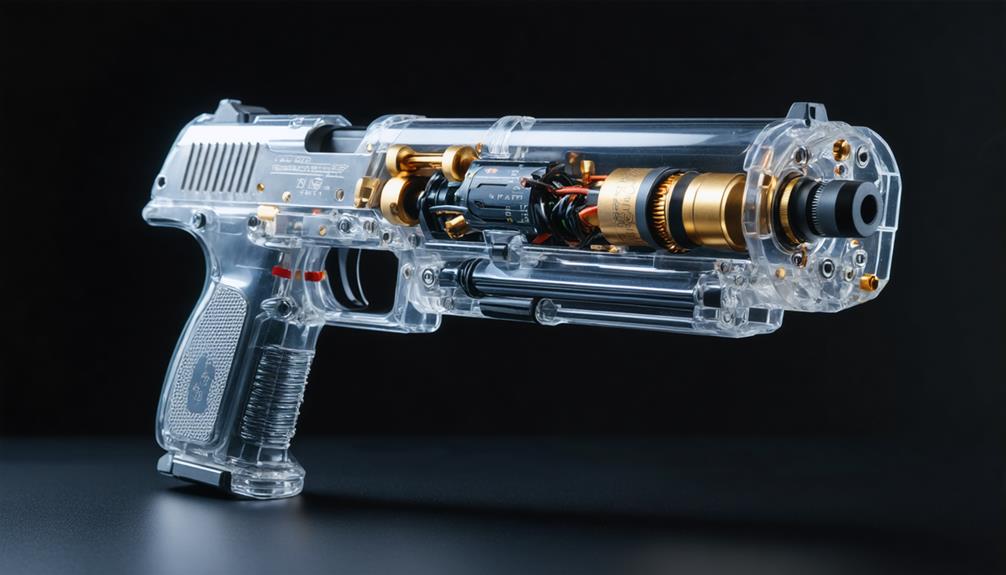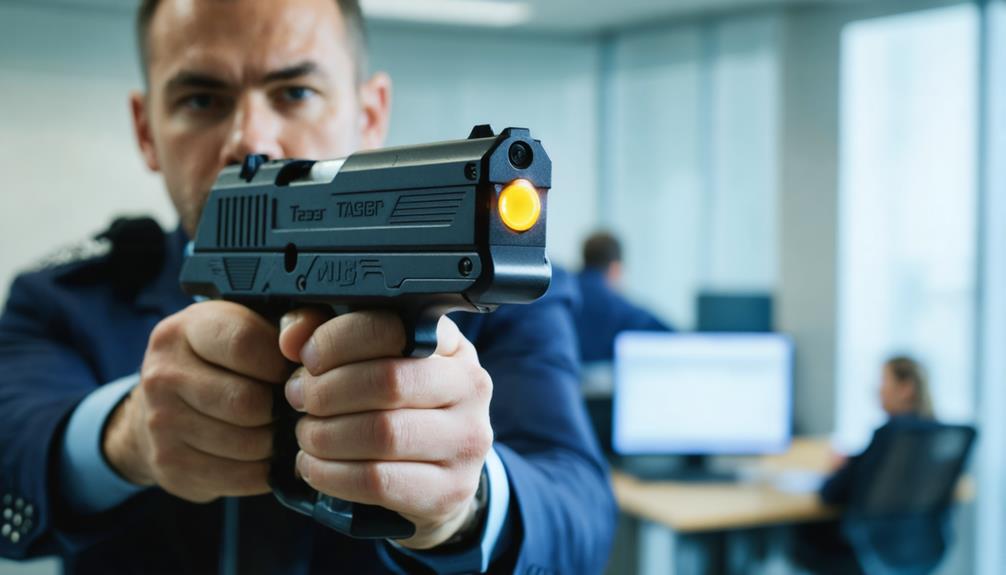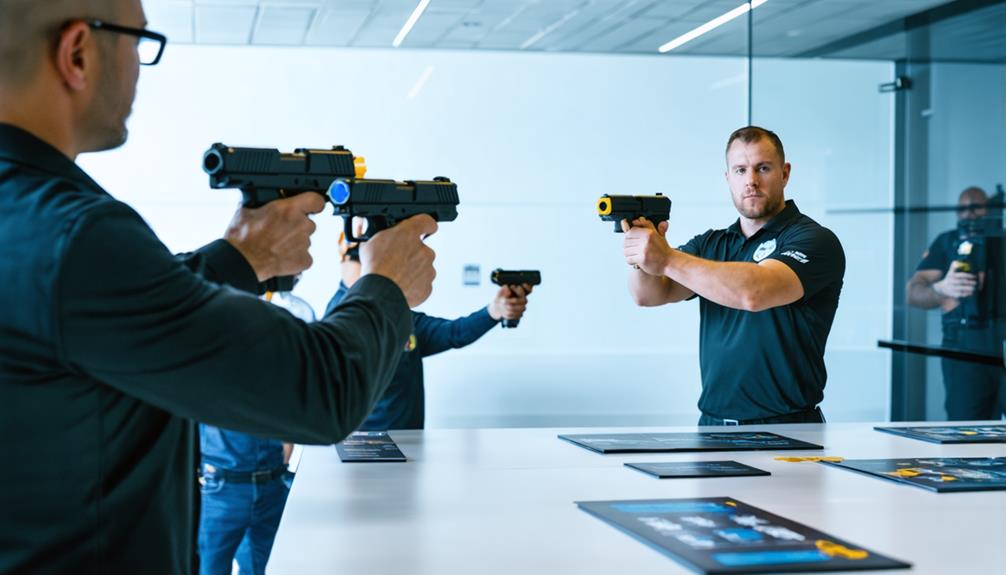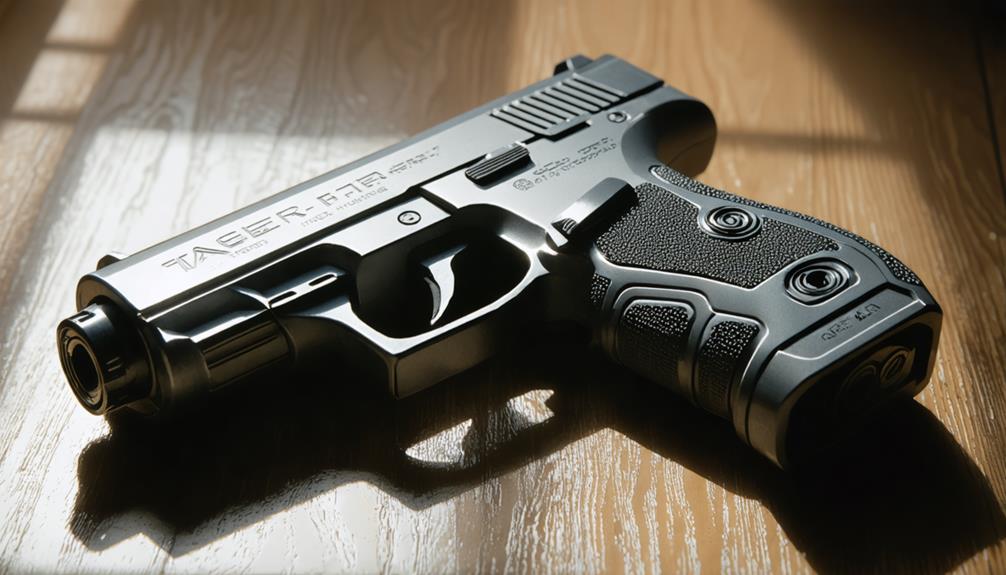
Brainstorm Security Shop

For Orders Over $199

On Any Of Our Products

Details On Refund Page
The Professional Taser Gun, a pivotal innovation in non-lethal weaponry, serves a crucial role in modern law enforcement and personal defense. Initially developed in the 1970s, it has evolved to incorporate advanced features, such as precise targeting systems and ergonomic designs, enhancing its effectiveness. While it offers the advantage of minimizing long-term injuries, the ethical implications and safety considerations surrounding its use remain subjects of ongoing debate. As technology progresses, what future advancements could redefine its role in ensuring public safety and trust? This question invites a deeper exploration into its multifaceted impact on society.
The history and development of the professional Taser gun is a fascinating journey that traces back to the early 1970s, a period marked by increasing demand for non-lethal law enforcement tools. Conceived by Jack Cover, a NASA researcher, the original Taser prototype was created in 1974. It was an innovative solution aimed at providing law enforcement agencies with effective alternatives to firearms, reducing the risk of fatal encounters.
This initial invention sparked the taser evolution, leading to significant advancements over the decades. The Taser gun’s development was driven by the need to equip officers with a reliable means of subduing suspects without causing permanent harm.
Early models, powered by gunpowder, faced regulatory challenges and required further refinement to gain acceptance among law enforcement agencies. As technology progressed, the Taser evolved into a sophisticated electronic control device, utilizing compressed nitrogen to propel electrodes and deliver an incapacitating electric charge.
How has the professional Taser gun evolved to become an essential tool in modern law enforcement? Through continuous advancements in design specifications, the Taser gun has become more effective, reliable, and user-friendly. The latest models incorporate cutting-edge technology that enhances precision and reduces the risk of unintended harm. Compact yet powerful, these devices are engineered with ergonomic designs that ensure ease of use under high-pressure scenarios. User testimonials highlight the Taser’s role in de-escalating potentially dangerous situations, offering a non-lethal alternative to firearms while maintaining officer safety.
The following table summarizes the key features of modern professional Taser guns, illustrating their enhancements in design and functionality:
| Feature | Description | User Feedback |
|---|---|---|
| Ergonomic Design | Optimized for comfort and control | “Fits perfectly in hand, intuitive to use.” |
| Range | Extended effective range up to 25 feet | “Allows safe distance from suspects.” |
| Battery Life | Long-lasting power support for extended use | “Reliable even during long shifts.” |
| Precision | Advanced targeting system for accuracy | “Improves hit rate significantly.” |
| Safety Features | Built-in safeguards to prevent misuse | “Enhances overall safety for all parties.” |
These features underscore the Taser’s pivotal role in law enforcement, providing an effective tool that aligns with modern policing standards and requirements.

The operational mechanism of a professional Taser gun primarily centers on its electrical discharge process, which temporarily disrupts voluntary muscle control.
This mechanism is activated via a trigger system designed with integrated safety features to prevent accidental discharge.
Understanding these components is crucial for appreciating how Tasers serve as effective tools for law enforcement and personal defense.
While a professional Taser gun appears simple in its operation, the underlying electrical discharge process is a sophisticated mechanism that ensures its effectiveness. At its core, the Taser gun deploys an electrical charge designed to incapacitate a target temporarily. This process involves a series of precise steps: once the electrodes connect with the target, the Taser delivers a high-voltage, low-current electrical pulse. These pulses are critical in disrupting voluntary control of muscles, effectively immobilizing the target without causing permanent harm.
Key aspects of the electrical discharge process include:
This intricate balance of electrical dynamics underlines the Taser’s role as a reliable tool in modern policing.
Engaging the Taser’s trigger initiates a finely tuned operational mechanism designed to ensure both efficacy and user safety. At the heart of this mechanism is trigger sensitivity, which is calibrated to require deliberate activation, thereby preventing accidental discharge. This sensitivity is crucial in high-stress situations where precision is paramount. The Taser’s trigger system is engineered to respond only to a specific pressure threshold, allowing the user to maintain control over the device at all times.
Integral to the Taser’s design are its comprehensive safety protocols. These include a dual safety switch that must be disengaged before the device can be activated. This two-step safety feature acts as a critical safeguard, reducing the likelihood of unintended use.
Furthermore, contemporary models incorporate visual and auditory indicators, such as LED lights and beeping sounds, to confirm the Taser’s readiness status and alert the user when the device is armed.
These features collectively ensure that the Taser can be deployed efficiently while minimizing risks to both the user and others. The balance between trigger sensitivity and robust safety protocols exemplifies a commitment to responsible design, underscoring the importance of precision and safety in law enforcement tools.
The professional Taser gun offers significant benefits, including enhanced safety measures that protect both law enforcement personnel and the public.
Its capacity for effective threat deterrence makes it an invaluable tool in diffusing potentially dangerous situations swiftly.
Furthermore, as a non-lethal defense option, it provides a crucial alternative to firearms, reducing the risk of fatal outcomes during confrontations.
Implementing enhanced safety measures in professional Taser guns significantly reduces the risk of injury during law enforcement engagements. By integrating advanced technology and design improvements, these devices prioritize user safety while ensuring public confidence in law enforcement practices.
Enhanced safety measures address potential hazards, thereby fostering a safer environment for both officers and the communities they serve. This proactive approach aids in building community awareness regarding the responsible use of Tasers, promoting transparency and trust.
The incorporation of enhanced safety features in Tasers provides numerous benefits:
Building on the foundation of enhanced safety measures, effective threat deterrence emerges as a vital component in the utilization of professional Taser guns. These devices offer significant advantages in various tactical applications, particularly within law enforcement contexts. By providing officers with a tool that can incapacitate potential threats from a distance, Taser guns effectively reduce the need for physical confrontation, thus minimizing the risk of injury to both officers and suspects.
| Benefit | Description |
|---|---|
| Distance Engagement | Enables safe apprehension from a distance, reducing risk |
| Rapid Deployment | Quick to activate, ensuring timely response |
| Psychological Impact | Visual and auditory cues deter threats |
| Versatility | Adaptable to different tactical scenarios |
| Officer Safety | Lowers risk of close-quarters combat injuries |
The psychological impact of a Taser gun’s visual and auditory cues often serves as a deterrent, discouraging aggressive behavior before escalation. This proactive approach aligns with law enforcement’s goal of maintaining public safety while ensuring officer protection. Furthermore, the versatility of Taser guns makes them adaptable to various tactical scenarios, allowing officers to tailor their response to the specific threat level. In conclusion, professional Taser guns stand as a pivotal asset in law enforcement, offering a reliable means of effective threat deterrence.
In contemporary law enforcement and personal security contexts, professional Taser guns serve as a paramount non-lethal defense option, offering several distinct benefits and advantages.
These devices provide a means to incapacitate potential threats without the permanent consequences associated with lethal force. This aligns seamlessly with modern self-defense strategies, which prioritize minimizing harm while maintaining personal safety.
Tasers bridge the gap between verbal warnings and lethal measures, providing law enforcement and civilians alike with a critical tool to ensure security without escalation.
The advantages of using Taser guns as a non-lethal defense option include:

How can we ensure the safe use of professional Taser guns? User safety and user responsibility are paramount when handling such devices. Proper training is essential, providing users with the knowledge to operate Tasers effectively and safely. Comprehensive training programs should cover operational procedures, potential risks, and situational awareness, ensuring that users can make informed decisions when deploying the device.
User responsibility extends beyond initial training. It requires ongoing commitment to adhere to safety protocols and keep abreast of updates in Taser technology and usage guidelines. Regular practice and refreshers on usage techniques can reinforce safe handling practices, minimizing the risk of accidents or misuse.
Additionally, employing safety features inherent in professional Taser guns can further safeguard against unintended discharges. Features such as safety locks, clear sight lines, and ergonomic designs are vital in promoting user safety.
Manufacturers must ensure that these devices align with stringent safety standards and undergo rigorous testing before reaching the market.
Ultimately, maintaining a balance between effective non-lethal defense and user safety relies on a combination of thorough training, personal accountability, and the incorporation of robust safety features in professional Taser guns.
The deployment of professional Taser guns is surrounded by complex legal and ethical issues that demand careful consideration.
The legal implications associated with their use require stringent regulatory frameworks to ensure accountability standards are upheld. For law enforcement, this involves clear guidelines and use restrictions to prevent misuse and protect public safety.
The ethical considerations extend to the psychological impact of Taser use, not only on the individuals targeted but also on the broader community, influencing public perception and trust.
The use of Taser guns by civilians introduces additional layers of complexity. While intended for self-defense, civilian use must be weighed against potential misuse and the need for comprehensive legal frameworks to regulate possession and application.
Ethical dilemmas arise when considering the balance between personal safety and public risk.

Effective training and certification are pivotal in ensuring the safe and responsible use of professional Taser guns. As these devices are deployed to manage volatile situations, proper mastery of their operation is crucial.
The cornerstone of effective training lies in comprehensive training techniques, which encompass both theoretical knowledge and practical application. Trainees are instructed on Taser mechanics, physiological effects, and situational appropriateness. Practical exercises often involve role-playing scenarios designed to simulate real-life encounters, allowing trainees to practice decision-making and judgment under pressure.
Certification requirements for Taser use are stringent and standardized, ensuring that only those who demonstrate proficiency and understanding are accredited. Individuals must complete a prescribed curriculum, which includes a minimum number of training hours and successful completion of both written and practical examinations.
Recertification is typically required on a regular basis, maintaining high standards of competency and adapting to any updates in Taser technology or protocol.
Moreover, ongoing education is encouraged, as it reinforces the principles of responsible Taser use and updates users on evolving best practices. By adhering to rigorous training techniques and certification requirements, professionals can effectively mitigate risks associated with Taser deployment, prioritizing safety for both users and subjects.
Looking ahead, the realm of professional Taser guns is poised for significant advancements driven by technological innovation and evolving law enforcement needs.
Central to these advancements will be the integration of smart technology, enhancing both functionality and safety. The future may see Taser guns that incorporate augmented reality for improved targeting and situational awareness, providing officers with critical data overlays in real-time.
As wearable devices gain traction, Tasers with modular design elements could easily integrate with existing law enforcement equipment, offering seamless tactical integration.
Enhanced connectivity and data analytics will further revolutionize Taser usage. The ability to collect and analyze data from each deployment will provide invaluable insights, optimizing both training and operational effectiveness.
User customization options will allow agencies to tailor devices to specific needs, enhancing usability and officer adaptability in diverse situations.
Potential innovations include:
These trends will undoubtedly shape the next generation of professional Taser guns, ensuring they remain indispensable tools for modern law enforcement.
Taser gun technology differs from a traditional firearm by delivering non-lethal electric shocks to incapacitate individuals, rather than discharging bullets. Legal implications involve regulations on usage, ensuring compliance with laws governing non-lethal force for law enforcement.
The effective range of a standard taser gun is typically 15 to 25 feet. Taser accuracy is crucial within this range to ensure the electrical discharge properly incapacitates the target without causing unintended harm or collateral damage.
Age restrictions for taser gun ownership vary by jurisdiction, with some areas imposing specific age limits. Legal implications and safety concerns often necessitate these restrictions to ensure responsible use and to prevent misuse among younger individuals.
The taser functionality is generally reliable across various weather conditions. However, weather impact, such as heavy rain or extreme cold, may influence performance, potentially reducing effectiveness and range. Users should consider environmental factors during deployment for optimal results.
Regular maintenance involves diligent battery care and an inspection routine to ensure optimal performance. It’s essential to check battery levels frequently and inspect for signs of wear or damage to maintain the device’s reliability and safety.
The Professional Taser Gun represents a significant advancement in non-lethal law enforcement technology, emphasizing safety and effectiveness. Its development in the 1970s introduced an ergonomic design and advanced targeting systems to disrupt muscle control with minimal injury risk. Safety measures and proper training ensure responsible use, enhancing trust in public safety. Legal and ethical considerations remain critical as future trends and innovations continue to shape its role in law enforcement and personal self-defense.
